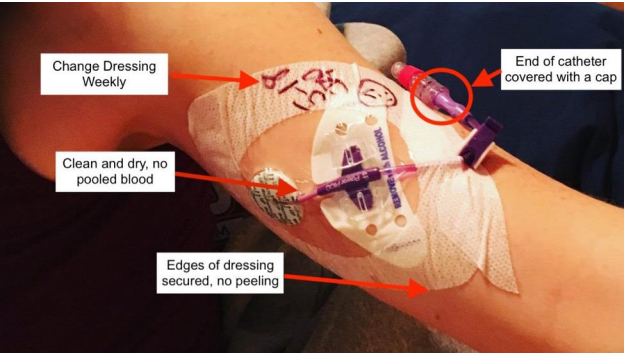What to Look For

Protect The VAD
Prevent infection. Use good hand hygiene. Don’t touch the catheter or dressing unless you need to, and always clean your hands before and after you come in contact with it. Your caregivers, family members, and visitors should use good hand hygiene, too.
The catheter and dressing must stay dry. Do not take baths, swim, or do things that could get it wet. Cover it with plastic wrap or otherwise seal it to shower; afterwards, take the wrap off and make sure it stayed dry. If not, call your healthcare team for help.
Avoid damage. Do not use any sharp or pointed objects around the catheter. This includes scissors, pins, knives, razors, or anything else that could cut it or put a hole in it. Do not let anything pull or rub on the catheter, such as clothing, children, and animals.
Don’t squeeze. Avoid restrictive garments or bands, and do not take your blood pressure on the catheter arm.
Watch for issues. Watch for cracks, leaks, or damage. If the catheter appears to have come partially out, or the dressing becomes dirty, wet, or the edges come loose, call your healthcare team for help.
Protect Your Arm
Use your arms for normal daily activities – lack of movement can lead to blood clots. Your healthcare team may suggest light arm exercises.
Avoid strenuous activities like sports or heavy weightlifting unless your healthcare provider says it’s OK. Do not lift more than 10lb with a catheter in your arm.
Avoid activities causing pain. Talk to your healthcare team if you have concerns about pain or range of motion.
Good Hand Hygiene
To wash your hands with soap and water:
- Wet your hands with warm water. (Avoid hot water, which can cause skin irritation when you wash your hands often.)
- Apply enough soap to cover the whole surface of your hands, including your fingers.
- Rub your hands together vigorously for at least 15 seconds. Make sure to rub the front and back of each hand up to the wrist, your fingers and fingernails, between the fingers, and each thumb.
- Rinse your hands with warm water.
- Dry your hands completely with a new, unused paper towel. Do not use a cloth towel or other reusable towel. These can harbor germs.
- Use the paper towel to turn off the faucet, then throw it away. If you’re in a bathroom, also use a paper towel to open the door instead of touching the handle.
When you do not have soap and water: Use a 60% or more alcohol-based hand gel to clean your hands. Follow the instructions on the package. Your healthcare team can answer any questions you have about when to use hand gel, or when it’s better to wash with soap and water.
When To Get Help
Call your healthcare team if you have any of the following:
- If you hear a rushing sound or have sensations in your neck during infusion
- Pain or burning in your shoulder, chest, back, arm, or leg
- Swelling in your arm
- Fever of 100.4F (38.0C) or higher
- Chills
- Pain, redness, drainage, burning, or stinging at the catheter site
- Coughing, wheezing, or shortness of breath
- A racing or irregular heartbeat
- Muscle stiffness or trouble moving
- Tightness in your arm, above the catheter site